#5th century sculpture
Text
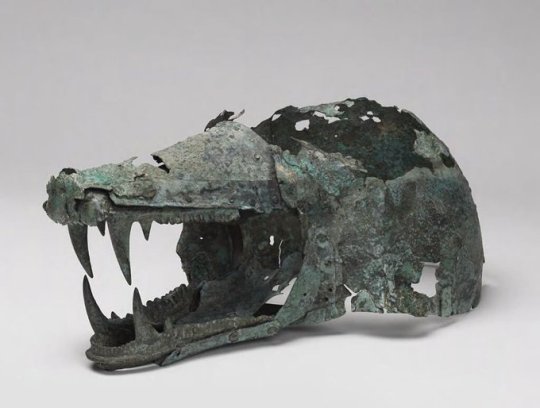
Etruscan Bronze Helmet in the Shape of a Wolf’s Head
6th-5th centuries BCE.
#Etruscan Bronze Helmet in the Shape of a Wolf’s Head#6th-5th centuries BCE#Wolf's Head Helmet#Head of a Boar#bronze#bronze helmet#bronze sculpture#ancient artifacts#archeology#archeolgst#history#history news#ancient history#ancient culture#ancient civilizations#etruscan history#etruscan art
4K notes
·
View notes
Text

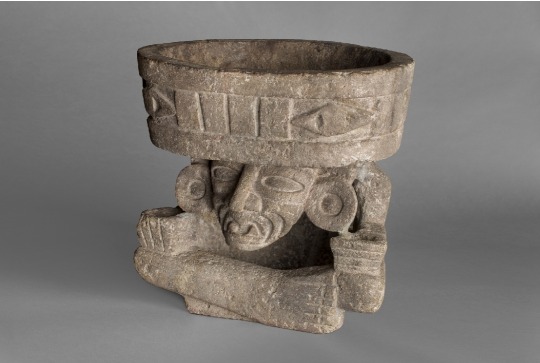




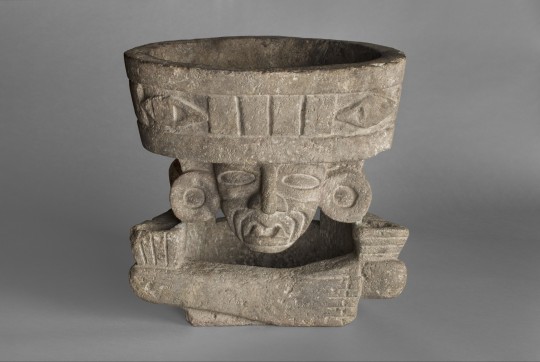
~ Brazier in the Form of the Old God.
Place of origin: Teotihuacan, Mexico
Period: Early Classic period (250 B.C.–A.D. 600)
Date: ca. A.D. 400–500
Medium: Basalt
#ancient#ancient art#history#museum#archeology#ancient sculpture#ancient history#5th century#6th century#Teotihuacan#mexico#mesoamerica#early classic period#basalt#a.d. 400#a.d. 500
609 notes
·
View notes
Text




Pyxis, Etruscan, 7th-5th century,
Greek · Attic, 5th century B.C.
Molded in the form of a ram’s head, the muzzle black-glazed, with reserved areas along the grooves at the end of the nose, the nostrils and the mouth, the bulging eyes in added white, with thick molded lids, the fleece composed of a series of tiny raised pellets, the underslung horns ribbed, the black-glazed ears emerging from within, wisps along the forehead in dilute glaze
The bowl with the goddess Aphrodite enthroned on a klismos, her right elbow leaning on the back of her chair, her left forearm resting on her leg, a dove standing on the chair beside her, her winged son Eros standing with a fan behind her, a draped female standing before her, wearing a rayed diadem, presenting her with an alabastron in her extended right hand, her drapery held up in her left, Ares further to the right, depicted nude but for a himation pinned at his neck, his dagger secured by a baldric, spears in his left hand, a draped female before him with a phiale in her extended left hand; palmettes on either side of the handle, with two dotted circles in between
The vessel perforated at the ram’s mouth.
Terracotta, L: 21 cm
Courtesy: Phoenix Ancient Art
#art#history#design#style#archeology#sculpture#antiquity#ram#terracotta#etruscan#ares#pyxis#aphrodite#klismos#7th century#5th century#greece
36 notes
·
View notes
Text
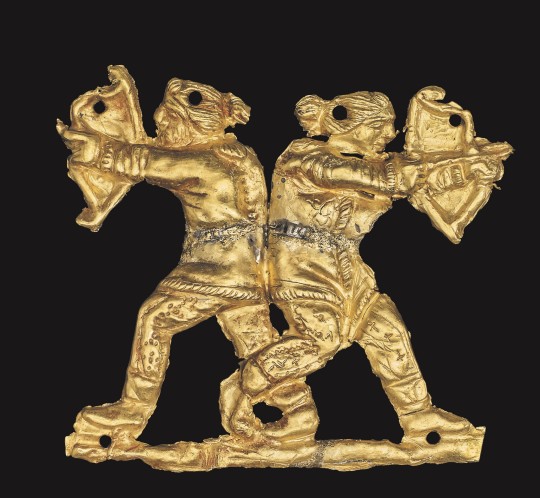
Scythian archers 400 BCE. Gold sew-on clothing appliqué in the form of two Scythian archers back to back, probably blood-brothers. Possibly of Greek manufacture for Scythian buyer.
"Babylonian texts frequently mention gimirrāya (literally “Cimmerians”). The reference is probably to members of the Saka (Scythian) tribes of Central Asia, who spoke one of the Old Iranian dialects. In Achaemenid Babylonia they served in the king’s army. Among the Sakai in the Persian army in Babylonia were those whose job it was to guard the boats carrying official cargoes by order of the Persian administration. A document of the year 524 mentions Scythians with the Iranian names Usukaya and Tattakkaya (M. A. Dandamayev, “Saka Soldiers on Ships,” Iranica Antiqua 22, 1982, pp. 101-02).
As early as the seventh century B.C. the Scythians had mounted raids on Western Asia, and a Scythian influence on Babylonian armor is noticeable even before the Persian conquest of Mesopotamia. The soldiers of Nebuchadnezzar II and Nabonidus were often equipped with Scythian bows, Scythian bronze- and iron-tipped arrows, and various other Scythian items including Scythian harnesses for their horses. In the pre-Persian levels at Babylon archeologists have found bronze arrowheads of the Scythian type. These technological borrowings occurred because the Scythian bows were vastly superior to the Babylonian in their ballistic qualities (M. A. Dandamayev, “Data of the Babylonian Documents from the 6th to the 5th Centuries B.C. on the Sakas,” in Prolegomena to the Sources on the History of Pre-Islamic Central Asia, ed. J. Harmatta, Budapest, 1979, pp. 95-109)."
-taken from iranicaonline
#scythian#scythian gold#european art#sculpture#history#statue#art#antiquities#pagan#paganism#ancient art#archaeology#the british museum#museums#5th century bce
249 notes
·
View notes
Text
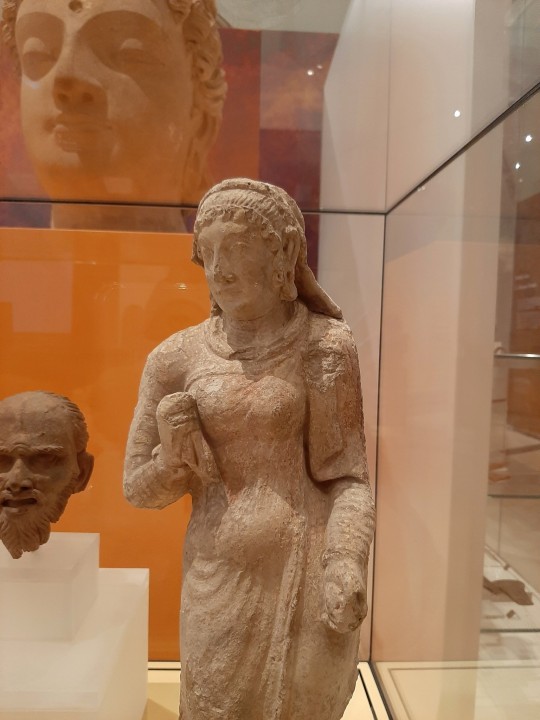
Standing woman
Gandhara, Afghanistan
Painted stucco
Kushan period, 4th-5th century
#can't believe i got to see her irl after i posted her like last year#she's bigger than i expected#women#gandhara#Afghanistan#mine#stucco#kushan#4th century#5th century#sculpture
36 notes
·
View notes
Photo
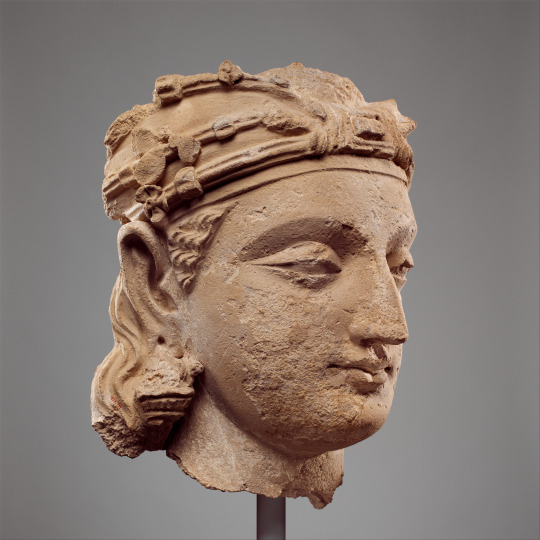
Monumental Bodhisattva Head, 5th century
Pakistan (ancient region of Gandhara)
Stucco
H. 19 3/4 in. (50.2 cm); W. 10 in. (25.4 cm); D. 10 in. (25.4 cm)
This head comes from a sculpture that would have been more than twelve feet tall and likely stood along the perimeter of a Buddhist sacred area enclosing a stupa. By the fourth and fifth centuries monumental imagery became increasingly popular in Gandhara and was almost exclusively restricted to images of the Buddha. The bodhisattva’s turban and jewelry might indicate that he is a rare image of Shakyamuni prior to enlightenment. Alternatively, the bodhisattva may have attended the Buddha as part of a massive triad.
Collection of the Metropolitan Museum of Art
#stucco#sculpture#Pakistan#Gandhara#Buddhism#bodhisattva#figure#cultural amalgam#5th century#art#art history#The Met#Metropolitan Museum of Art
16 notes
·
View notes
Text

Anonymous Greek sculptor. Pig statuette. 5th century BC, The Walters Art Museum, Baltimore.
3 notes
·
View notes
Text
Greek sculptors of the 5th century BCE were the first named artists whose fame in their own time was matched by their subsequent reputation.
1 note
·
View note
Text


The Riace Bronzes were found in the sea off the coast of Italy in 1972. They are life sized, bearded warriors cast in the 5th century BCE. Ancient Greek bronzes rarely survive as many were later melted down. We only really know how Ancient Greek bronze sculptures looked like because the Romans were copycats.
Reggio di Calabria, Italy
#ancient art#Ancient Greek#Ancient Greece#bronze#statue#art history#Italy#Italia#Reggio calabria#travel#original photography#iphonography#museum#archaeology#photographers on tumblr#photography#lensblr#history#wanderingjana
518 notes
·
View notes
Text

Hekate is known as a protector of entryways, borders, and crossroads. She is also a Cthonic (underworld) goddess who exists on the peripheries of the pantheon, and teaches witches like Circe and Medea their magical crafts. Therefore, she has darker associations with death, the underworld, the moon, magic spells, and spirits.
In Hesiod’s Theogany, Hecate is the daughter of Titans Perses and Asteria. For defeating the giant Pergamon in the Gigantomauchy (epic battle between Olympians and Giants), Hekate is the only Titan to retain her powers under the rule of Zeus, who gives Hecate a share of earth, heaven and sea.
One of the most famous myths involving Hecate is Hades’ abduction of Demeter’s daughter, Persephone. Hekate assists Demeter in the underworld by leading the way with torchlight, and later becomes an attendant to Persephone. Hecate’s sacred animal ally is a black dog, said to be Hecuba, Queen of Troy, who was reincarnated by Hekate after suicide. Another sacred animal servant is the Polecat (weasel), who was the handmaiden Galinthias punished for a deception involving the birth of Hercules.
Around the 5th century B.C.E. we see the first sculptural totem figures portraying Hekate in the triple body form surrounding a central column. These votive statues for the protection of travelers would be placed at crossroads with each figure facing a different path.
Hekate is associated with a variety of frightening Daimones (minor divinities or spirits which could be good or evil.) the Empusae was a shapeshifting specter with the body of a woman, and one leg of brass and the other of a donkey, with hopes of devouring a traveler. The Lamia was originally a vengeful Libyan serpentine woman who devoured children, but later was seen to take the form of attractive, voluptuous woman who would seduce a traveler and feast on their fresh blood. The Mormo was another phantom bogeyman said to be sent out by Hekate to nibble on misbehaving children.
Thanks again for everyone's suggestions. Hope you like the final painting! Please share it if possible. Xoxo
#pagan#hellenism#greek mythology#tagamemnon#mythology tag#percyjackson#dark academia#greek#greekmyths#classical literature#percy jackon and the olympians#pjo#homer#iliad#classics#mythologyart#art#artists on tumblr#odyssey#literature#ancientworld#ancienthistory#ancient civilizations#ancientgreece#olympians#greekgods#agamemnon#troy#trojanwar
546 notes
·
View notes
Text
Sirens of Greek Myth Were Bird-Women, Not Mermaids
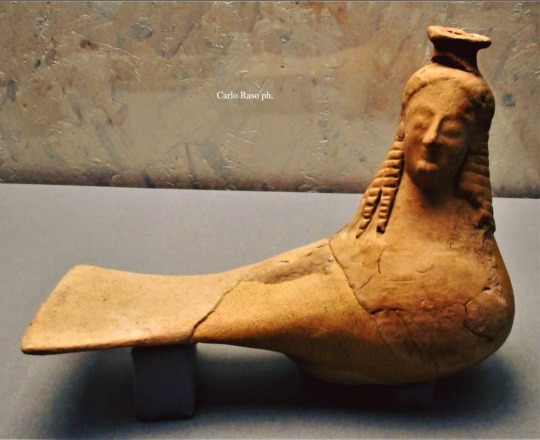
Bottle-askos in the shape of a siren (2nd half 6th century BC) from Locri / Southern Italy's Calabria. National Museum of Magna Graecia (Reggio Calabria, Italy).
In the wine-dark expanse of the Mediterranean Sea, far from the halls of civilization, there was once a small island—or so Homer, the famed poet of Ancient Greece, wrote in his epic The Odyssey. No buildings occupied its flowery meadows; no fisherman worked its shores. Those who passed in their black ships heard only voices, twining over the windless waves, singing a song that promised knowledge of all things. Once they heard it, they were enchanted; they had no choice but to land and seek out the singers. Those who did never left the island; their bodies remained, rotting amid the flowers, for none who heard the Sirens' song could escape it.
The story of the Sirens has inspired writers, poets, and artists for millennia. But somewhere along the way their form was confused. Today, Sirens are almost always represented as voluptuous mermaids, whose beauty and sexuality lure men to their deaths. But the Classical Greeks understood the Sirens differently: as bird-women, creatures that Mediterranean cultures traditionally associated with hidden knowledge.

Sirens first appear in the literary record with the Odyssey (written around 750 BCE) in a segment that’s much briefer than you’d think considering the cultural impact of these mystical, singing creatures. It goes like this: Odysseus, warned by the enchantress Circe of the danger posed by the Sirens’ song, orders his crew to stuff their ears with wax. But, curious to a fault, he has himself bound to the ship’s mast so he can listen without flinging himself into the sea. The Sirens promise him tales of all that had occurred during the war at Troy, and everywhere else besides; enchanted, he begs his crew to release him. He rants, raves, and threatens, but to no avail. His crew sails on until the song fades in the distance, and so saves his life.
Homer doesn’t describe the Sirens’ physical appearance in his epic poem, Wilson says. But in ceramic paintings and tomb sculptures from the time of writing, and centuries after, Sirens were usually depicted with taloned feet, feathered wings, and a beautiful human face. The bird-body of the Siren is significant to Wilson: In the eyes of traditional peoples all across Europe, birds were often graced with an otherworldliness associated with gods, spirits, and omens.

They inhabit the water, the air, and the earth. They’re also associated with song; they have voices that are not human voices, and kinds of movement that are not the same as human kinds of movement.
The Sirens’ role in tomb art is particularly telling. In ancient Mediterranean and Middle Eastern cultures—as far back as 7,000 years ago—birds were often depicted carrying spirits to the underworld. In Southern Italy's Calabria, archaeologists unearthed several Greek askos (unguentary vessel) in shape of sirens, most commonly found in tombs.
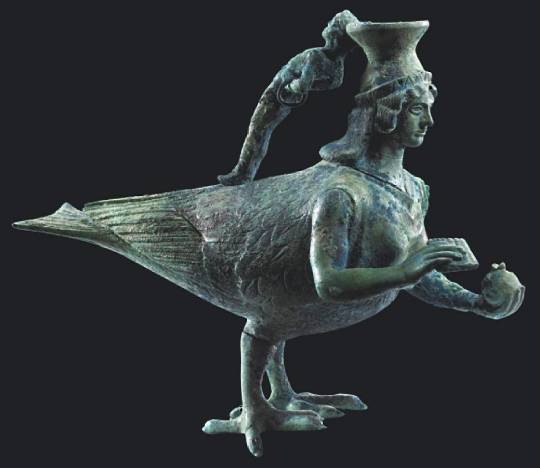
Bronze askos in the shape of a siren (5th century BC) from Crotone, Calabria, Italy - Archaeological Museum of Crotone.
Jump ahead a few millennia to 1,550 BCE, by which time Ba-birds, depictions of departing souls as human-faced birds, began appearing in Egypt. That connection between birds and dead souls seems to have then hopped over to Greece: Writing in the 5th century BCE, the playwright Euripides described the Sirens as at the beck and call of Persephone, one of the rulers of the underworld, while other writers identified the Sirens as rivals and dark echoes of the Muses, those goddesses of creativity.
These are the Sirens the Ancient Greeks would have recognized: bird creatures of the underworld, bridging the human world and what lies beyond. The Sirens—and their fateful songs—then offered a glimpse behind the veil, a chance to hear how earthly glories would echo in eternity. The question of what song the Sirens sing, what is this forbidden knowledge, what's wrong with it, what's the temptation—the text leaves a lot of open space there. Therein lies the seduction.
Yet today, mermaids or beautiful sea nymphs replace the dark, winged Sirens of ancient times.
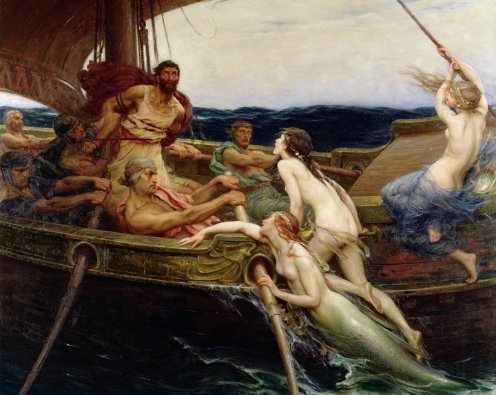
It is during the Middle Ages that the image of the siren began its shift from bird-woman to mermaid . With the transformation of the siren's image, the attributes associated with female monsters shifted. This suggests a change in the traits that were considered monstrous in women. The siren's movement from a frightening bird-woman to a beautiful mermaid represents female beauty becoming monstrous. Throughout the Middle Ages sirens increasingly represented a male fear of female seduction, suggesting a growing fear of female sexuality.
For medieval Christians, sirens were heavily associated with female sin.
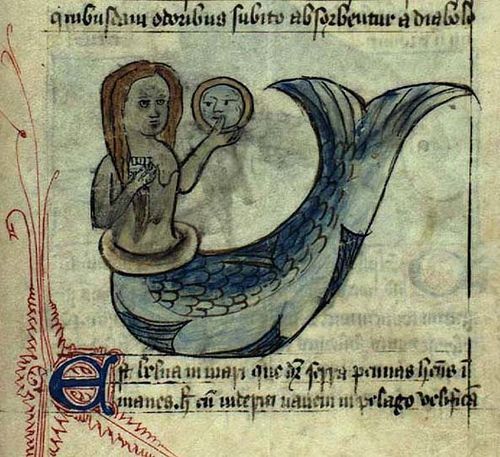
However it happened, the identification of Sirens with mermaids seems to have affected later translations of the Odyssey, and ultimately common knowledge of Sirens. Translators in the 19th and 20th centuries cast the Sirens in a sexualized light. In one prose translation, the Sirens speak of “the sweet voice from our lips,” despite the word στομάτων directly translating to the less sensual “mouths.” Another adds flowery descriptors of “each purling note/like honey twining/from our lips.” But unlike the Odyssey’s other island temptresses, Circe and Calypso, the Sirens get no admiring description of their faces or hair. Only their voice is described, and their field of bones and flowers.

That’s a pretty strong indicator that the Sirens are not meant to be read as offering a sexual temptation. You can kiss lips; mouths devour.
Folklore and mythology move on, given enough time. Today, the Siren is just another word for mermaid, and is likely to remain so. But there’s something richly thematic about the Sirens of Classical Greece that deserves to be remembered: in-between creatures on a lonely island, floating between the boundaries of life and death, and offering an irresistible song of both. Water-temptresses are a dime a dozen; the Sirens offer wisdom.
Follow us on Instagram, @calabria_mediterranea

#sirens#calabria#homer#italy#italia#south italy#southern italy#mediterranean#mediterranean sea#the odyssey#ancient greece#greek#greek art#art#terracotta#greek mythology#greek myth#underworld#mermaids#mythological creature#magna graecia#magna grecia#locri#folklore#mythology#siren#mermaid#crotone
87 notes
·
View notes
Text

The piercing gaze of the ancient Greeks.
A collection of some famous Greek sculptures looking directly at...you
From left to right:
1) Antikythera Philosopher, 250 BCE
2) Athena of Piraeus, 4th century BCE
3) Head of Hygeia, 5th-4th cen. BCE
4) Antikythera Ephebe, 4th cent. BCE
5) Unknown man from Delos, c. 100
BCE
6) Head of a Goddess, 2nd cent. CE
📸 ArysPan
#dark academia#light academia#academia aesthetic#classical#academia#escapism#classic literature#books#books and libraries#architecture#greek#statue#sculpture#eyes#antikythera#Athena of Piraeus#Head of Hygeia#royal core#cottage core#aesthetic
904 notes
·
View notes
Text


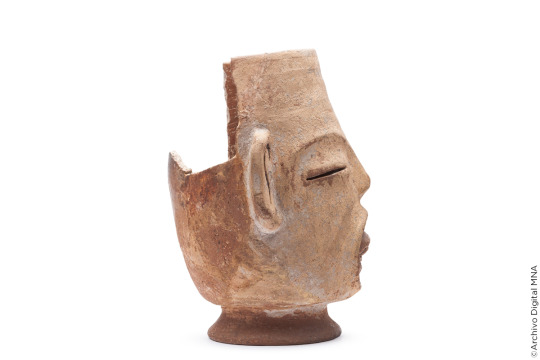


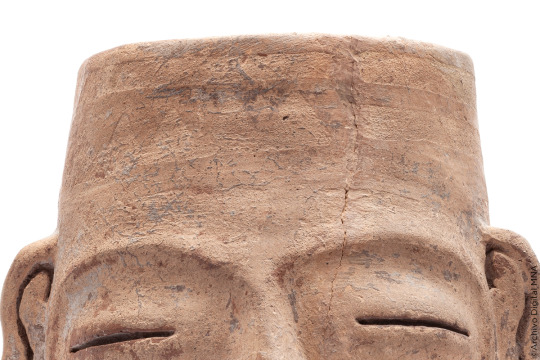
~ Effigy vessel of Xipe Tótec.
Date: A.D. 400 to 700
Place of origin: Border area between Guerrero and Michoacan, Mexico
• From the source: This unique vessel was found as part of an offering inside a grave located in La Luz, an ancient settlement located on the banks of the Balsas River in Michoacán. In addition to the vessel, the offering that accompanied the deceased consisted of nine obsidian blades and six shell beads.
#ancient#ancient art#history#museum#archeology#ancient sculpture#ancient history#archaeology#ancient america#pottery#mexico#mexican#xipe totec#a.d. 400#a.d. 700#Michoacán#guerrero#5th century#8th century
266 notes
·
View notes
Photo

Laocoön: The Suffering of a Trojan Priest & Its Afterlife
The sculpture group of Laocoön and His Sons, on display in the Vatican since its rediscovery in 1506, depicts the suffering of the Trojan prince and priest Laocoön (brother of Anchises) and his young sons Antiphantes and Thymbraeus and is one of the most famous and fascinating statues of antiquity. In his Natural History, Pliny the Elder states that the Laocoön, created by the eminent Rhodian sculptors Hagesander, Polydorus, and Athenodorus, “is a work of art to be preferred to any other painting or statuary” (36.37). Among art historians, the sculptural group has received near-universal acclaim ever since its rediscovery under questionable circumstances in 1506.
Is the statue famously shown since its discovery in the newly designed Belvedere Garden at the Vatican Palace actually the ancient sculpture mentioned by Pliny, or rather a clever Renaissance forgery? If the latter, who may have contrived this masterful deception? If the former, is it an original, or a marble copy of a Hellenistic bronze made for a Roman patron?
Beware of Greeks Bearing Gifts
In the most famous version of the story, as told by Virgil (70-19 BCE) in his Aeneid, Laocoön had warned his fellow citizens against the Greeks “even if they bear gifts,” and had tried to expose the true nature of the wooden horse by striking it with a spear (the wooden horse in question, of course, being the notorious “Trojan Horse”, left by the Greek forces on the coast so as to provide access into the city to the troops hidden inside the construction). When later two serpents emerged from the sea to kill the priest and his sons, the Trojans interpreted their horrific deaths as an act of divine retribution and promptly decided to move the wooden horse into the city, believing the contraption to be an offering to Minerva (Athena).
According to Arctinus of Miletus, the earliest tradition of the tragedy (surviving only through later citations), Apollo had sent the two serpents to kill Laocoön and only one of his sons; while the later author Quintus of Smyrna maintains that the serpents killed both sons but spared the father.
Servius, another late authority (c. 400 CE), tells us how Laocoön managed to incur the wrath of Apollo by sleeping with his wife before the cult statue in the god's temple. An even later source, the Byzantine scholar Tzetzes, adds that the scene of Laocoön's death took place in the very temple of the Thymbraean Apollo – appropriately setting the punishment at the scene of the crime.
The 5th-century BCE Greek playwright Sophocles produced a tragedy on the subject, of which only a few fragments survive in later citations. Apart from the sources mentioned above, Hellenistic poets Apollodorus and Euphorion, the historian Dionysius of Halicarnassus, the Roman novelist Petronius, the Latin fables attributed to Hyginus, and a few other fragments, all provide various details of the tragic story.
Despite this appearance in ancient literature from the post-Homeric to Byzantine traditions, artistic representations of Laocoön's suffering are few and far between. Depictions appear in some Greek vase paintings (5th to 4th centuries BCE) and in two frescoes at Pompeii (c. 25-75 CE). The marble statue group of Laocoön and His Sons, therefore remains the most exceptional portrayal of only a handful of ancient works illustrating the suffering of Laocoön.
Continue reading...
59 notes
·
View notes
Text

Siberian wolf 5th-3rd C. BCE. Wood with shell inlays. Overall: 11.1 x 3.3 x 5.9 cm (4 3/8 x 1 5/16 x 2 5/16 in.). Its subject, size, materials, and naturalistic style suggest that this small sculpture was made by one of the nomadic peoples of Western and Central Asia---perhaps the Scythians. From the Cleveland Art Museum.
"The Neuri follow Scythian customs; but one generation before the advent of Darius' army, they happened to be driven from their country by snakes; for their land produced great numbers of these, and still more came down on them out of the desolation on the north, until at last the Neuri were so afflicted that they left their own country and lived among the Budini. It may be that these people are wizards; for the Scythians, and the Greeks settled in Scythia, say that once a year every one of the Neuri becomes a wolf for a few days and changes back again to his former shape. Those who tell this tale do not convince me; but they tell it nonetheless, and swear to its truth."
-Herodotus, The Histories 4.105.1
#scythian#siberian#wolf#antiquities#artifacts#herodotus#werewolf#werewolves#literature#history#ancient history#pagan#paganism#ancient greece#statue#sculpture#5th century bce
197 notes
·
View notes
Text

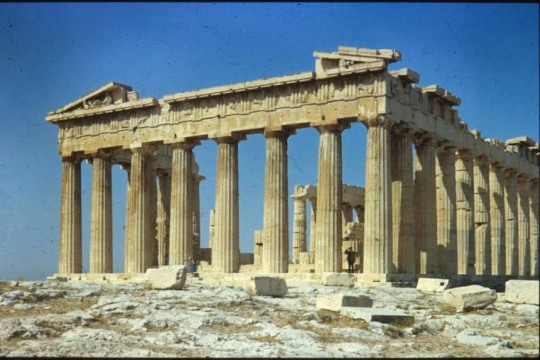
What Happened to the Parthenon? The Destruction of the Parthenon in 1687
Today the Parthenon in Athens is considered one of the most important and impressive structures of ancient Greece. Originally built in 438 BC, the structure served a number of roles. During classical ages it was a temple dedicated to the goddess Athena. When Christianity became the dominant religion in the Roman Empire it transformed into a Christian church. When the Ottoman Empire conquered the Byzantine Empire in the 15th century, it was again transformed into an Islamic mosque. Today, however, the Parthenon is a ruin of marble columns, a shell of its former glory. This was not caused by weather or the fact that the structure is thousands of years old. Often, buildings and monuments are looted, it's stones pilfered by stone masons in order to construct other buildings. Such is the case with the Egyptian pyramids, Hadrian's wall, the Roman Colosseum, and countless other sites. However, with the Parthenon this was also not the case, at least not for the bulk of it's destruction. Throughout most of its history the Parthenon was a well respected, well maintained, and a heavily used building. So what happened to the Parthenon?
In 1687 the Ottoman Empire was at war with the Republic of Venice. On September 21st, 1687 an army of 10,000 Venetian soldiers under the command of Francesco Morisini landed on the outskirts of Athens with the intent of capturing the city as well as the rest of Greece. The Venetians laid siege to the city and began a six day bombardment with mortars and siege cannon. In their haste to defend the city the Ottoman Turks fortified the Acropolis and turned the Parthenon into a gunpowder magazine, a storage place for gunpowder, cannonballs, small arms shot, and other munitions. Later during the siege a captured Turkish deserter revealed to Morisini the location of the Ottoman powder magazine. Morisini ordered the Parthenon targeted by his cannon and the gunpowder magazine was ignited by a mortar shell. The resulting explosion blew off the roof, caused the structure's internal walls to crumble, destroyed 3/5ths of the structures sculptures, and destroyed several columns, mostly on the south side where the shell entered the building. The resulting blast also killed 300 Turkish soldiers.
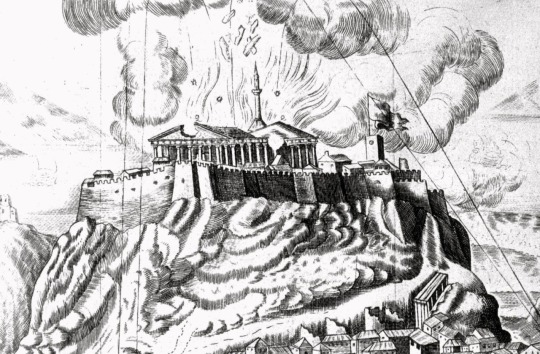
With the Turks supply of gunpowder destroyed the Venetians easily conquered the city. Then the looting began, with Morisini and his troops removing ancient treasures and statuary as prizes of war. Many statues were accidentally smashed during removal, the rest were shipped off to collections in Italy, where they eventually were scattered all over Europe. After the devastating explosion of the Parthenon, centuries of secondary destruction occurred, mostly in the form of looting, which finally did begin to occur now that the building had been badly damaged and left abandoned. Stone masons carted off wagon loads of marble for use in other building projects and structures. In 1801 the British ambassador to the Ottoman Empire, Thomas Bruce, 7th Earl of Elgin, became fascinated with the Parthenon, studying its architecture closely and documenting it's magnificence. He then proceeded to loot the Parthenon of its remaining statuary, especially the statues that make up the front facade of the building. 17 statues, 15 panels, and a large 247 foot long frieze were removed and shipped to Britain, where they were sold to the British Museum.
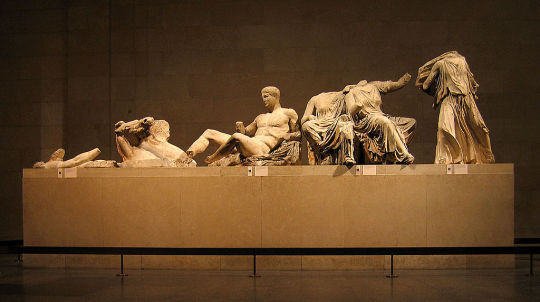

Today the statuary, known as the Elgin Marbles, are a source of contention between the United Kingdom and Greece, as the Greeks want them back. The remains of the Parthenon are still under threat, especially from the slow destruction of acid rain erosion. In 1975 the Greek government began the project to preserve and restore the Parthenon, with slow painstaking work occurring over the decades.
736 notes
·
View notes